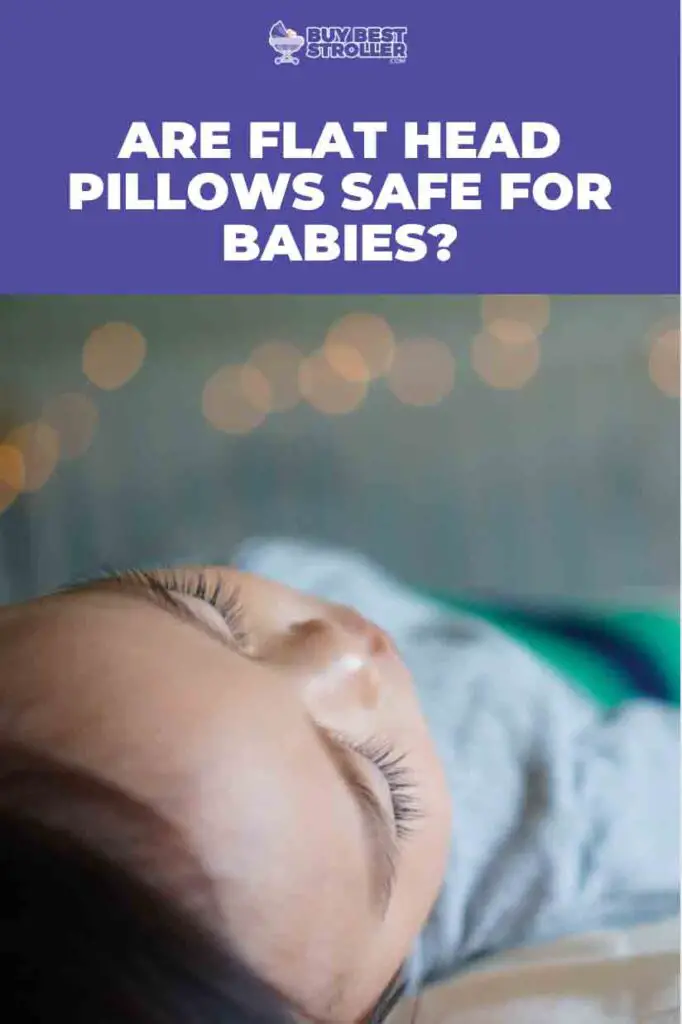No, Flathead pillows are not safe for babies. Flathead syndrome, also known as plagiocephaly, is a condition in which one part of the baby’s soft skull flattens, leaving the baby’s head abnormally shaped. This condition occurs when babies sleep on their backs with their heads in the same position for long periods.
Today, parents actively search for the best newborn head pillow to prevent flat head syndrome in their babies. Some people consider plagiocephaly pillows or flat head pillows to be one of the most accessible and affordable ways of preventing flat head syndrome, but it is not medically recommended and is considered unsafe for babies.
If you use a flat head pillow for your baby, you may put your baby at risk for other complications like Sudden infant death syndrome (SIDS), overheating, and even suffocation. In addition, flat head pillows may also lead to other, more serious complications.
In some cases, a pillow may cover the baby’s face, obstructing breathing or causing overheating.
During sleep, when a baby is propped up on a pillow, his/her head can fall forward, which will cause his/her chin to drop down to his/her chest. In this situation, his/her airway can be blocked, and airflow can be reduced.
If anything is placed inside the pillow, there is always a risk of SIDS (Sudden Infant Death Syndrome). Therefore, it is important to take all the necessary precautions when using a flathead pillow.

So, are flathead pillows safe for babies?
No, it is not safe but if you use a flat head pillow for your baby, make sure that you take all the necessary precautions to avoid any potential problems.
Are Flat Head Pillows Safe For Babies and Do They Work?
Flat head pillows have proven successful for some parents. But flat head pillows may cause SIDS in babies, so it’s strongly recommended you always supervise babies when using flat head pillows, especially for babies under two years old.
When Flat head pillows don’t work, your doctor may recommend a helmet or surgery. It is usually possible to fix mild flat head syndrome if you reposition your baby while they are awake.
Can Flat Head Be Corrected At 7 Months?
Yes, a baby’s flat head can be corrected at the age of 7 months using helmet therapy. Studies show that helmet therapy is most effective between the ages of four and seven months since repositioning techniques become less effective.
Although it can be a concern for new parents, flat head syndrome rarely harms babies and usually resolves itself within a few months. It’s okay if your baby’s head is flat or pointy because it will be gone before you know it.
A baby’s head shape generally does not affect the development of the brain or other organs in the body. In reality, most insurance companies and doctors consider flat spots to be cosmetic issues. So how do you know whether your baby needs a helmet?
Your doctor will check the shape and size of your baby’s head at each well-child visit. These visits usually occur every 2 months during infancy. The doctor may prescribe a helmet if your newborn has a large flat spot that isn’t going away after 4 months of age.
Helmets are most effective when they are used between 4 and 6 months old. By doing this, the helmet will gently shape your baby’s skull as they grow. Usually, treatment is not effective after age 1 due to the skull has begun to fuse together.
What Age Does Baby Head Shape Become Permanent?
At the age of 2 years, a baby’s head shape becomes permanent. In general, a baby’s skull takes between 9 and 18 months to fully form. This is the time when some babies develop positional plagiocephaly. It means that the head has a flat area on the back or side. It only affects the shape of the head, not growth or development.
As soon as your baby’s cranial sutures have fully closed, his head shape is fully formed. During childhood, the skeleton continues to develop but remains flexible. About four months after birth, the soft spots begin to come together in the head and the back fontanelle closes, while the frontal fontanelle closes between 9 and 18 months.
However, even after the soft spots have closed, they will remain flexible throughout childhood so that the head and face can continue to grow and remodel. You should seek treatment as soon as possible if you suspect your baby has a flat head.
Does Sleeping Position Affect Baby’s Head?
Yes, sleeping position affects a baby’s head. If you let your baby change positions frequently, you can prevent the flat head syndrome. Additionally, you should consider any other factors that may cause the flat head syndrome, including birth defects and genetic abnormalities.
AAP recommends that infants sleep on their backs to prevent Sudden Infant Death Syndrome (SIDS). It’s safest for babies to sleep on their backs because it opens the airways and reduces the risk of choking.
How Long Does It Take For A Baby’s Head To Round?
Usually, A baby’s head will take anywhere from 2 days to a few weeks to grow into its adorable, round shape after they are born. However, if babies spend too much time on their backs later in infancy, they can develop flat heads. So, it is important to keep an eye on your baby’s head shape and growth during the early weeks and months of his or her life.
When your baby’s cranial sutures are fully closed, their head shape has fully developed. During childhood, the skeleton will continue to develop and remain flexible. At about four months, the soft spots in the head start to come together, and the fontanelle at the back of the head closes, and the frontal fontanelle closes between 9 and 18 months.
Related Topics:
- How To Get Baby To Sleep In Bassinet? ( 4 Best Practices )
- Should I Stop Solids If Baby Is Constipated?
- How Long Should a Newborn Sleep Without Feeding?
- Does Warm Formula Help With Reflux? Things to take care of
- 7 Pros and Cons Of Baby Sleeping On Stomach




